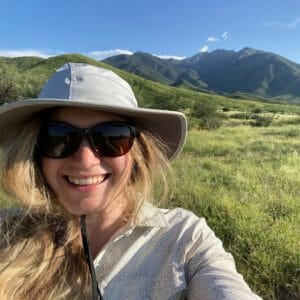
In this series, we’re meeting with Swette Center team members to explore their background in food systems, what they are currently working on, and their vision of food systems transformation.
Read on for an interview with Colleen Hanley, Senior Food Systems Specialist.
When did you first get interested in food systems work?
During my undergrad degree, which was at the University of Vermont, I started out as a biology and psychology major. For fun, I took this extracurricular course that was called Coffee Ecology and Livelihoods. I was an avid coffee drinker and loved drinking coffee. During the course, our professor delved into this systems-level perspective of coffee production. I got to learn from her research in Central America and coffee production and we took trips to roasters in Vermont. I became really amazed by how transdisciplinary coffee was and how the study of coffee intersected with all of these different things, like biodiversity and climate change, mitigation and adaptation economics, farmers’ rights, etc. I had so much fun in this single class that I ended up changing my major by the end of the semester to Environmental Studies with a concentration on Food, Land, and Community. And that was kind of where it all began. After that I started working at farms and dived right into food systems.
What are you working on?
Currently, I am assisting the Swette Center in a pilot study that uses True Cost Accounting for beef livestock in Arizona and Colorado. I’ve had the opportunity to visit ranches across the state and interview ranchers while taking field samples on some really breathtaking rangelands, and seeing all different types of cattle, which is always fun.
True Cost Accounting evaluates dependencies and outcomes across four capitals: produced, human, social, and natural capital. By doing this, we’re trying to progress this more holistic way of evaluating the true cost of food. For example, what would be the true cost of a hamburger if we looked at the dependencies and outcomes across this holistic view?
What do you think is a priority in transforming food systems?
I think from a process standpoint, systems-level perspective and stakeholder engagement is key. In food systems, we often get stuck in these kinds of separate silos of our expertise. How do we bridge those silos and create that transdisciplinary systems perspective in the work that we do? Stakeholder engagement is really important because you need a diverse set of stakeholders to promote bottom-up solutions in these complex problems.
From a content standpoint, one area that I think is a priority for me is this idea of land sharing for agriculture to serve as a biodiverse hub, and it doesn’t necessarily have to be setting aside land for conservation. So the question becomes how can we implement sustainable agriculture practices that promote wildlife and soil health, and conserve farmland in that manner?
Any advice for current food system students?
I would say to reach out to people whose work inspires you. I know it’s a little strange during the pandemic, but you can ask for a Zoom coffee date. When I was getting my Masters degree in Food and Nutrition, I often reached out to people who I admired. I would just call and say, “Hey, I read this paper you wrote– I thought it was incredibly interesting, and I especially liked this, this and this,” and then I would ask them to meet them over Zoom to have coffee and discuss further. I heard a lot of really interesting stories and got to know people more. So yeah, definitely don’t be shy. People are always willing to talk about food things with you if they’re doing the work in the field.
What is your favorite food to make?
I like food a lot, obviously. Right now, the colder weather is coming (although it doesn’t get that cold in Arizona), so I really enjoy a roasted root dish. At one of the farms that holds a special place in my heart and where I used to work, we’d always gather all of our root veggies on the table at the end of harvest and cut them up and make a root roast with cinnamon, nutmeg, chili powder, cayenne, garlic, and onion. It has turnips, radishes, potatoes, carrots, and lots of different colored beets. It’s a warm, happy dish that you can eat with a nice glass of red wine to celebrate winter coming. My second favorite food to make is stuffed artichokes. I just think that they’re so delicious and fun. I stuff them differently every time, but I always put a lot of lemon in them.